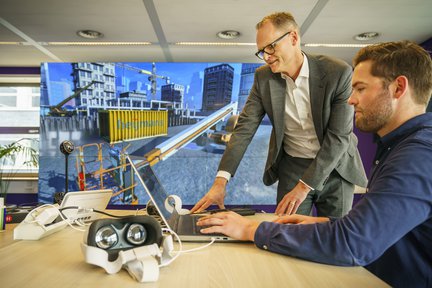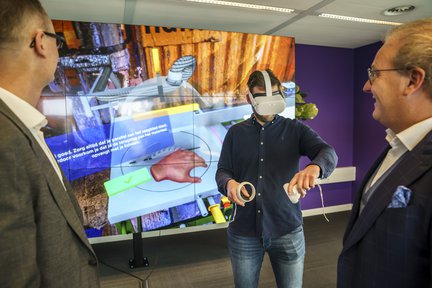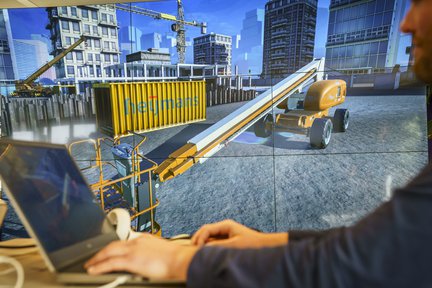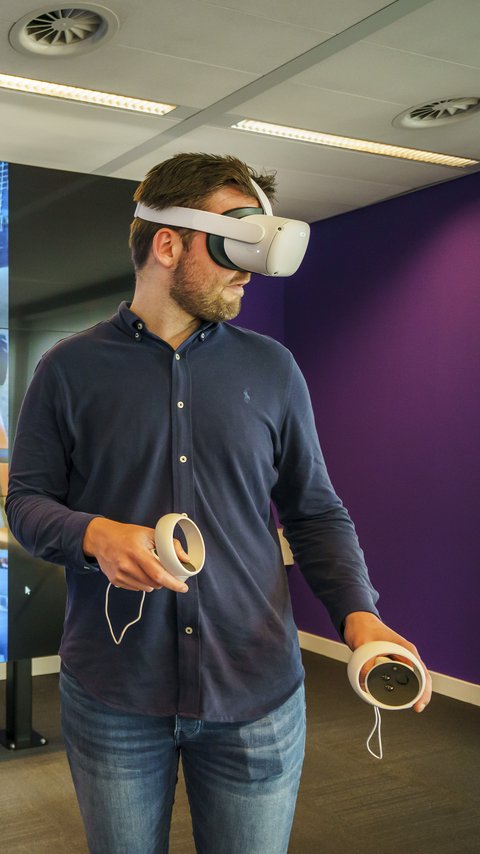
Educational and fun is how Heijmans employees describe the virtual reality (VR) training they receive at our building sites. In a simulation of their working environment, they can deal with risky situations in a life-like but safe manner. This increases the sense of safety and contributes to the future of digital construction. "The learning impact is enormous."
Handling a sawing machine, making choices under time pressure and working at height: Heijmans employees have recently started to do this virtually. With large VR goggles on their heads and two controllers in their hands, they can experience potentially risky situations at first hand. In this virtual building site, they practice a number of scenarios: what happens if you forget your safety goggles or do not make the right adjustments to a saw? They can make mistakes in complete safety in this environment. A specially trained Heijmans colleague gives instructions, watches the images the VR goggles wearer sees on a large screen and monitors their reactions.

Virtual building site
A healthy and safe working environment is a major priority at Heijmans. For example, the company launched the GO! (Geen Ongevallen or, no accidents) programme in 2013, to foster proactive safety behaviour. Virtual reality training is now part of that programme. "We already use virtual reality in many projects, because it allows you to experience a space more realistically than with a 3D simulation on a computer," says Hans ten Brinke, Director of Design & Engineering at Heijmans. "When we were looking for a way to make the building site even safer, we came up with the idea of using virtual reality in a safety training course. This gives us a chance to combine safety with other themes that are very important to us: digitalisation and innovation."

In the meantime, Heijmans has developed three training courses: working at height, order & tidiness and the sawing shed. For the latter, this meant visualising an existing Heijmans building in 360 degrees using pointcloud scanning, including sawing equipment and instructions on the wall. "The objects and people in that world may just be visuals, but the environment has to look life-like," says Ron Koenen. He is director of KPE Groep, a Heijmans partner that develops training programmes for the construction and real estate sectors. "It's important that employees recognise the virtual environment. If they do, employees don't feel as if they're playing a game, but rather stepping onto the shop floor. We've done a lot of research into the effect of VR applications. This has shown, among other things, that if you gain experience in a realistically simulated situation that you cannot experience in reality without risk, everything you learn sticks better."
Enormous learning impact
The training courses are given at Heijmans building sites, to groups of about fifteen employees, during so-called toolbox meetings. "These are monthly meetings with a major focus on the theme of safety." Hans ten Brinke explains. "We devote attention to the 'big six', the most common causes of accidents, and to ways of reducing and preventing them. You can provide training for this in all kinds of ways, but the use of virtual reality has a much greater impact than other visual management methods. For instance, only VR gives you that feeling that you are really going to fall if you don't do something the right way. That adds an extra dimension to the training."
Afterwards, the group discusses the scenarios they have practiced. What went well, what could be improved? Did the participants display safe behaviour? "The knowledge sticks," says Ron Koenen. "You see a clear change in behaviour: people work more consciously and safely after these training sessions. They increase safety awareness. Employees are very enthusiastic about the VR training: over ninety percent say it helps them to work more safely, and they give the training courses a score of eight or higher. Many employees also say that they would like to do this kind of training course again. Hans ten Brinke: "Keeping safety top of mind can sometimes be difficult, because for some the subject feels too much like an obligation. But everyone is enthusiastic about these training courses. For us, that's confirmation that we're on the right track."
You see a clear change in behaviour. They increase safety awareness
Employees are not the only ones to learn from the VR experience: Heijmans also uses the insights from the evaluation to improve training. These are always combined with other training methods, by the way. "Practical instructions and a someone senior looking on will always be necessary for the use of a sawing machine”, says Ron Koenen. “But VR can be used to good effect for many other skills. If you use it properly, the learning impact is enormous."

Future applications
Following the success of the first training courses - which won several industry awards - it is time to think about the next application possibilities of virtual reality for increasing safety. Many employees who have followed the training course come up with their own ideas, says Hans ten Brinke. "For example, our infrastructure business unit has already produced a training course to prevent excavation damage[g1] . And we get requests to simulate dangerous parts of construction sites in VR. This gives employees a chance to think about issues before they start building: how are we going to carry out this assignment? Who should stand where? Are all the safety measures in place?"
The use of virtual reality is increasing the sense of safety within the company and is also helping the industry as a whole to move forward. VR and the digitalisation of projects is also making it possible to design and build in a smarter fashion, says Hans ten Brinke. "So virtual reality is in effect a part of the broad application possibilities we see for building digitally in a safer manner."




